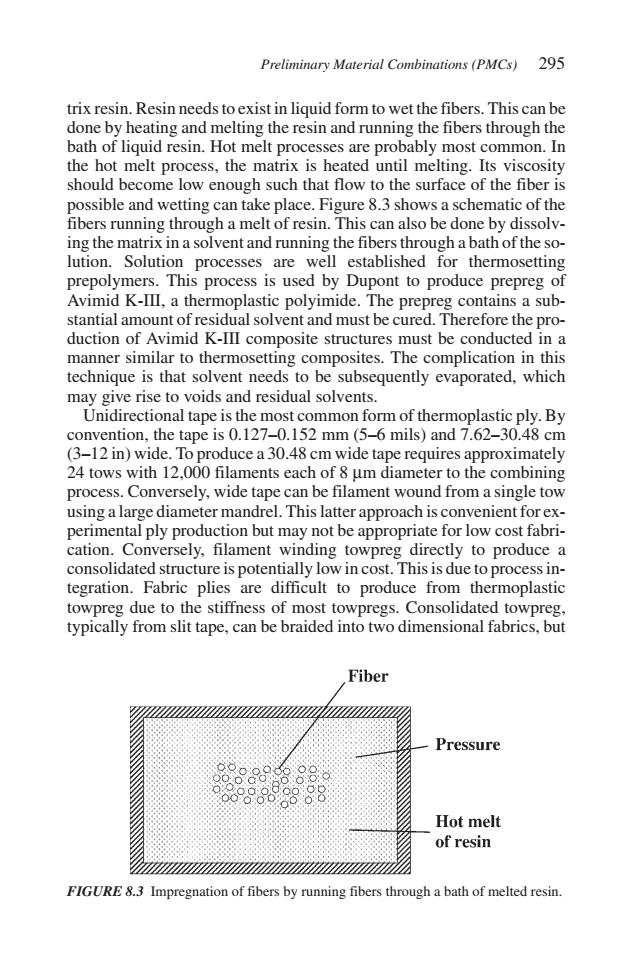正在加载图片...

Preliminary Material Combinations(PMCs) 295 trix resin.Resin needs to exist in liquid form to wet the fibers.This can be done by heating and melting the resin and running the fibers through the bath of liquid resin.Hot melt processes are probably most common.In the hot melt process,the matrix is heated until melting.Its viscosity should become low enough such that flow to the surface of the fiber is possible and wetting can take place.Figure 8.3 shows a schematic of the fibers running through a melt of resin.This can also be done by dissolv- ing the matrix in a solvent and running the fibers through a bath of the so- lution.Solution processes are well established for thermosetting prepolymers.This process is used by Dupont to produce prepreg of Avimid K-III,a thermoplastic polyimide.The prepreg contains a sub- stantial amount of residual solvent and must be cured.Therefore the pro- duction of Avimid K-III composite structures must be conducted in a manner similar to thermosetting composites.The complication in this technique is that solvent needs to be subsequently evaporated,which may give rise to voids and residual solvents. Unidirectional tape is the most common form of thermoplastic ply.By convention,the tape is 0.127-0.152 mm (5-6 mils)and 7.62-30.48 cm (3-12 in)wide.To produce a 30.48 cm wide tape requires approximately 24 tows with 12,000 filaments each of 8 um diameter to the combining process.Conversely,wide tape can be filament wound from a single tow using a large diameter mandrel.This latter approach is convenient for ex- perimental ply production but may not be appropriate for low cost fabri- cation.Conversely,filament winding towpreg directly to produce a consolidated structure is potentially low in cost.This is due to process in- tegration.Fabric plies are difficult to produce from thermoplastic towpreg due to the stiffness of most towpregs.Consolidated towpreg, typically from slit tape,can be braided into two dimensional fabrics,but Fiber Pressure Hot melt of resin FIGURE 8.3 Impregnation of fibers by running fibers through a bath of melted resin.trix resin. Resin needs to exist in liquid form to wet the fibers. This can be done by heating and melting the resin and running the fibers through the bath of liquid resin. Hot melt processes are probably most common. In the hot melt process, the matrix is heated until melting. Its viscosity should become low enough such that flow to the surface of the fiber is possible and wetting can take place. Figure 8.3 shows a schematic of the fibers running through a melt of resin. This can also be done by dissolving the matrix in a solvent and running the fibers through a bath of the solution. Solution processes are well established for thermosetting prepolymers. This process is used by Dupont to produce prepreg of Avimid K-III, a thermoplastic polyimide. The prepreg contains a substantial amount of residual solvent and must be cured. Therefore the production of Avimid K-III composite structures must be conducted in a manner similar to thermosetting composites. The complication in this technique is that solvent needs to be subsequently evaporated, which may give rise to voids and residual solvents. Unidirectional tape is the most common form of thermoplastic ply. By convention, the tape is 0.127–0.152 mm (5–6 mils) and 7.62–30.48 cm (3–12 in) wide. To produce a 30.48 cm wide tape requires approximately 24 tows with 12,000 filaments each of 8 µm diameter to the combining process. Conversely, wide tape can be filament wound from a single tow using a large diameter mandrel. This latter approach is convenient for experimental ply production but may not be appropriate for low cost fabrication. Conversely, filament winding towpreg directly to produce a consolidated structure is potentially low in cost. This is due to process integration. Fabric plies are difficult to produce from thermoplastic towpreg due to the stiffness of most towpregs. Consolidated towpreg, typically from slit tape, can be braided into two dimensional fabrics, but Preliminary Material Combinations (PMCs) 295 FIGURE 8.3 Impregnation of fibers by running fibers through a bath of melted resin